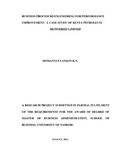| dc.contributor.author | Momanyi, Evanson K N | |
| dc.date.accessioned | 2013-02-28T11:34:52Z | |
| dc.date.issued | 2012-08 | |
| dc.identifier.uri | http://erepository.uonbi.ac.ke:8080/xmlui/handle/123456789/12350 | |
| dc.description.abstract | This research study sought to find out whether KPRL met its performance improvement
objective by implementing BPR in asset management system and the challenges it faced
which constrained its improvement.
The findings were based on both secondary and primary data. Secondary data was
collected from KPRL records covering six months pre- and post- BPR implementation.
This was the data available for post BPR implementation when the research study was
started. The consideration was for a single item transaction case with the initiator being a
technician level employee and approval up to the supervisor level only. Cost
consideration was for the initiator expenses exclusive of all other transaction associated
costs.
Primary data was obtained through interview where an interview guide was used to
collect data on BPR implementation challenges. Seven informants were targeted to
enable data capture for all the sections and categories involved in asset management.
They included; one engineering head of department, one engineering supervisor, one
mechanical technician, one instrument technician, one electrical technician, one materials
clerk and one contracts clerk.
The study found out that by implementing BPR in asset management, KPRL drastically
improved its materials approval process time by achieving a ten times reduction resulting
in an eleven times reduction in cost too as the two were noted to move in tandem. The
cost consideration represented part of the cost saving in the process and the full
consideration would result in a much high saving.
v
The study also found out that BPR implementation comes with a lot of challenges which
impacts the improvement achieved. On the part of KPRL out of the many challenges
considered, all came out with a significance rating of medium and above with medium
representing 57% and above representing 43%. The biggest challenge experienced by
KPRL was on communication of the project importance within the organization which
was rated high. Generally for any BPR undertaking, reasonable improvement levels can
only be achieved when all challenges are managed to the desired level | en |
| dc.language.iso | en | en |
| dc.publisher | University of Nairobi | en |
| dc.subject | business process reengineering | en |
| dc.subject | performance improvement | en |
| dc.subject | case study | en |
| dc.subject | kenya petroleum refineries limited | en |
| dc.title | Business process reengineering for performance improvement: a case study of kenya petroleum refineries limited | en |
| dc.type | Thesis | en |
| local.embargo.terms | 6 months | en |
| local.publisher | School Of Business, University Of Nairobi | en |

